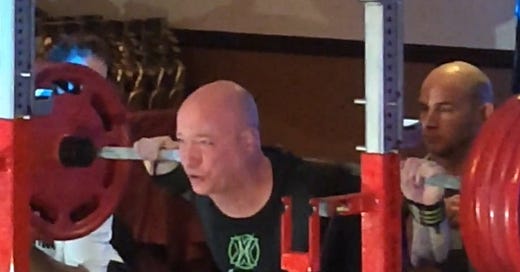“Life doesn’t get easier or more forgiving, we get stronger and more resilient.” -Steve Maraboli
I thought this would be a cool topic since I received so many messages regarding my statement in last week’s article noting the difference between using an exercise to build strength versus using an exercise to test strength.
A simple way to look at this from an exercise standpoint is through the sport of powerlifting. In powerlifting competition, the lifter has three attempts at the squat, bench press, and deadlift to establish their total, which is the sum of the three heaviest successful attempts in each lift. This implies that the three powerlifts are the lifter’s testers, while the exercises they perform in training are the builders.
Let’s take the deadlift, for instance. The deadlift performed in competition, in either the conventional or sumo stance, would be the lifter’s tester. The exercises performed in the off-season and preparation cycles would be the lifter’s builders. The lifter would select exercises to build the deadlift based on their individual strengths and weaknesses. If the lower back is the limiting factor in the deadlift, the lifter may work on the back extension or reverse hyper. If it’s the upper back, the lifter may focus on bent-over barbell rows and shrugs. If the lifter struggles with bracing, they might focus on abdominal and oblique exercises. If the glutes and hamstrings are the weak points, they may choose glute/hamstring raises, Romanian deadlifts, and good mornings. These special exercises would supplement the various deadlift-specific exercises such as deficit deadlifts, block deadlifts, and dynamic effort deadlifts.
The concept of ‘builders’ and ‘testers’ was something I first became aware of from Louie Simmons. The primary goal of his Westside Barbell Club was to push the sport of powerlifting to the absolute limit—something he and the many generations of lifters who trained with him did exceptionally well. During a talk once, Louie used the example of a fighter. In a nutshell, he said if one of the audience members kicked his ass, he wouldn’t fight him again immediately as he would just get beat again. Instead, he would go to various people to sharpen and hone his fighting technique, then, when he felt ready, he would go fight the individual again. The fighter he would be competing against was his tester, while his sparring partners were his builders. He then went on to address a point someone made to him that using a close-grip bench press would build a bench press. He said absolutely, but how do you build a close-grip bench press? The point was to break it down even further, and finding the weak muscular link in a chain was something he was amazing at. In a previous article, I talked about how he added 15 lbs to one of my female powerlifter’s bench press by simply looking at the muscular development of her shoulders and arms. Just by looking at her, he knew we were prioritizing triceps at the expense of her front deltoids. We implemented his corrective strategy, and six weeks later, her bench went from a tough 185 lbs to an easy 200 lbs at her next meet.
Exercises are not the only testers. For athletes, their sport performance is their tester. If they are displaying enhanced speed, strength, power, and/or endurance in their chosen arena of competition, then the builders they’ve chosen for their preparation are doing their intended job.
What about the majority of people simply seeking improved health, fitness, and longevity—those of us training for life, so to speak? I’m willing to bet this is the vast majority of my readers and subscribers. For us, testing our strength in the gym with 1-rep maxes is not necessary and may increase the likelihood of getting injured. For those of us in the over-40 club, injuries take much longer to heal than when we were in our teens and twenties. The last thing we need is to have to take a break from training due to injury. Consistent exercise is one of the best things we can do to enhance our longevity.
Instead, our testers are the things we want to do in life. Our hobbies, activities, and things we engage in during daily life are what we need to build our strength and fitness for. What are these things? It will differ person to person. If you’re like me, it’s being able to train jiu-jitsu, surf-skate, and hike with my dogs. For others, it may be the ability to lift a 25 lb suitcase into the overhead bin on an airplane unassisted. For some, it may be to carry and take care of their children and perform chores around the house unassisted.
If we are wrecking ourselves with max-effort squats and deadlifts in the gym, the recovery from these lifts will take away from the things in life we enjoy doing. On the other hand, if we perform exercises like squats, deadlifts, presses, and pulls with excellent technique for higher repetitions, we will build all the muscle and strength necessary to have an excellent quality of life and do the things we choose to do—hopefully until the day we move on from this lifetime.
While I have mixed feelings about Dr. Peter Attia and the information he presents, I am a big fan of his idea of the Centenarian Olympics. I would encourage you to determine what the events in your Centenarian Olympics will be, and build your fitness training program in a way that allows you to dominate those ‘games’!
I hope you enjoyed this week’s article, and until next time, stay strong and healthy!




